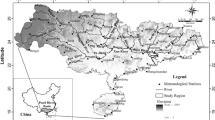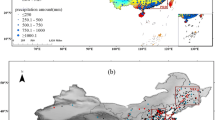Abstract
The precipitation pattern in the Taihu Lake basin in East China has significantly changed over the last decades, perhaps due to intensive urbanization. However, there is limited understanding of the effect of large-scale expansion of city groups on the precipitation variability, which causes a challenge for flood control in the basin. Considering the process of urbanization, we investigated in this study the variability of precipitation in different urban zones and characteristic scales and explored the influence of urban development on the rain island effect in the basin. The basin was divided into three zones (old urban area, new urban area, and suburbs) considering different degrees of urbanization. Results indicated that precipitation change and its response to urbanization had spatial differences at various characteristic scales. Urbanization exhibited a significant “precipitation enhancement effect” at the characteristic scales including annual, flood season, summer, autumn, and winter but indicated a “precipitation reduction effect” in spring. Annual (flood season) precipitation in 1990–2013 increased by 30.04 mm (16.94 mm), due to urbanization, compared with that in the preceding period. The rate of contribution of urbanization to precipitation increase was 15.6%, 41.1%, and 14.4% in summer, autumn, and winter. The enhancement effect of short duration rainfall extremes in old urban area was also discernible, and that in new urban areas would enhance along with urban expansion, complicating urban flood and waterlogging control. More effective adaptation strategies should be implemented to handle the unfavorable situation.









Similar content being viewed by others
Data availability
The data used in this study will be available (by the corresponding author) upon reasonable requests.
References
Cao Q, Yu D, Georgescu M et al (2018) Impacts of future urban expansion on summer climate and heat-related human health in eastern China. Environ Int 112:134–146
Chen SJ, Yin DP, Li YT et al (2016) Analysis of differences of rainfall between urban and rural regions in Nanjing. J Meteorol Environ 32(6):27–33
Cohen JE (2003) Human population: the next half century. Science 302(5648):1172–1175
Grimm NB, Faeth SH, Golubiewski NE, Redman CL, Wu JG, Bai XM, Briggs JM (2008) Global change and the ecology of cities. Science 319(5864):756–760
Hamed KH (2008) Trend detection in hydrologic data: the Mann-Kendall trend test under the scaling hypothesis. J Hydrol 349(3-4):350–363
Harman IN (2003). The energy balance of urban areas. University of Reading
Hoekstra AY, Buurman J, van Ginkel KCH (2018) Urban water security: a review. Environ Res Lett 13(5):053002
Hu QF, Zhang JY, Wang YT et al (2018) A review of urbanization impact on precipitation. Adv Water Sci 29(1):138–150
Huong H, Pathirana A (2011) Urbanization and climate change impacts on future urban flood risk in Can Tho city, Vietnam. Hydrol Earth Syst Sci Discuss 8(6):379–394
Huszar P, Belda M, Karlicky J et al (2018) Impact of urban canopy meteorological forcing on aerosol concentrations. Atmos Chem Phys 18(19):14059–14078
Jauregui E, Romales E (1996) Urban effects on convective precipitation in Mexico City. Atmos Environ 30(20):3383–3389
Kar SK, Liou YA, Ha KJ (2007) Characteristics of cloud-to-ground lightning activity over Seoul, South Korea in relation to an urban effect. Ann Geophys 25(10):2113–2118
Kaufmann RK, Seto KC, Schneider A, Liu ZT, Zhou LM, Wang WL (2007) Climate response to rapid urban growth: evidence of a human-induced precipitation deficit. J Clim 20(10):2299–2306
Kishtawal CM, Niyogi D, Tewari M, Pielke RA, Shepherd JM (2010) Urbanization signature in the observed heavy rainfall climatology over India. Int J Climatol 30(13):1908–1916
Li N, Xu YP, Chen S (2006) Influence of urbanization on precipitation in Suzhou City. Resour Environ Yangtze Basin 15(3):335–339 (in Chinese)
Li D, Wang X, Xie Y et al (2016) A multi-level and modular model for simulating the urban flooding and its application to Tianjin City. Nat Hazards 82(3):1947–1965
Li P, Li H, Yang G et al (2018) Assessing the hydrologic impacts of land use change in the Taihu Lake Basin of China from 1985 to 2010. Water 10(11):1512
Lin H, Sun JN (2014) Possible effects of urbanization on regional precipitation over Yangtze River Delta area. J Nanjing Univ (Nat Sci) 50(6):792–799 (in Chinese)
Locatelli L, Mark O, Mikkelsen PS, Nielsen KA, Deletic A, Roldin M, Binning PJ (2017) Hydrologic impact of urbanization with extensive stormwater infiltration. J Hydrol 544:524–537
Nam WH, Baigorria GA, Hong EM et al (2018) The fingerprint of climate change and urbanization in South Korea. Atmosphere 9(7):273
Pei FS, Wu CJ, Liu XP, Hu ZL, Xia Y, Liu LA, Wang K, Zhou Y, Xu L (2018) Detection and attribution of extreme precipitation changes from 1961 to 2012 in the Yangtze River Delta in China. Catena 169:183–194
Richards DR, Edwards PJ (2018) Using water management infrastructure to address both flood risk and the urban heat island. Int J Water Resour Dev 34(4):490–498
Sang YF (2013) Wavelet entropy-based investigation into the daily precipitation variability in the Yangtze River Delta, China, with rapid urbanizations. Theor Appl Climatol 111(3-4):361–370
Sang YF, Wang ZG, Li ZL, Liu CM, Liu XJ (2013) Investigation into the daily precipitation variability in the Yangtze River Delta, China. Hydrol Process 27(2):175–185
Sang YF, Wang Z, Liu C (2014) Comparison of the MK test and EMD method for trend identification in hydrological time series. J Hydrol 510:293–298
Shepherd JM (2005) A review of current investigations of urban-induced rainfall and recommendations for the future. Earth Interact 9(12):1–27
Shepherd JM (2006) Evidence of urban-induced precipitation variability in arid climate regimes. J Arid Environ 67(4):607–628
Song S, Xu YP, Wu ZF et al (2019) The relative impact of urbanization and precipitation on long-term water level variations in the Yangtze River Delta. Sci Total Environ 648:460–471
Sun JS, Shu WJ (2007) The effect of urban heat island on winter and summer precipitation in Beijing region. Chin J Atmos Sci 31(2):311–320
Trusilova K, Jung M, Churkina G, Karstens U, Heimann M, Claussen M (2008) Urbanization impacts on the climate in Europe: numerical experiments by the PSU–NCAR Mesoscale Model (MM5). J Appl Meteorol Climatol 47(5):1442–1455
Wang XQ, Wang ZF, Qi YB (2008) The effect of urbanization on winter precipitation in Beijing City. Sci China (Series D) 38(11):1438–1443
Xu YP, Ding JJ, Chen Y (2009) Impacts of urbanization on hydrology in the Yangtze River delta. Hydro-Sci Eng 4:67–73 (in Chinese)
Xu R, Hu Y, Gao H et al (2017) Derivation of fractional urban signals in better capturing urbanization process. Environ Earth Sci 76(12):412
Yin J, Liang SS (2010) Influence of urbanization on regional precipitation in Shanghai City. Hydrology 30(2):66–72
Zhang Y (2010) Heavy Rainfall in the Urban Environment. Princeton University
Zhang S, Huang G, Qi Y et al (2018) Impact of urbanization on summer rainfall in Beijing-Tianjin-Hebei metropolis under different climate backgrounds. Theor Appl Climatol 133(3-4):1093–1106
Acknowledgements
The authors gratefully acknowledge the most appropriate comments and suggestions given by the editor and the anonymous reviewer.
Funding
This study was financially supported by the National Key Research and Development Program of China (No. 2017YFA0603702), the National Natural Science Foundation of China (No. 51809252, 41971040), and the Youth Innovation Promotion Association CAS (No. 2017074), and the SINO-GERMAN Mobility Programme (M-0369).
Author information
Authors and Affiliations
Contributions
Jian Hu: methodology, software, data analysis, and writing original draft. Yong Liu: writing, and data analysis. Yan-Fang Sang: conception, methodology, writing, and revising. Changming Liu: review and editing. Vijay P. Singh: writing and editing.
Corresponding author
Ethics declarations
Conflict of interest
The authors declare no conflict of interest.
Additional information
Publisher’s note
Springer Nature remains neutral with regard to jurisdictional claims in published maps and institutional affiliations.
Rights and permissions
About this article
Cite this article
Hu, J., Liu, Y., Sang, YF. et al. Precipitation variability and its response to urbanization in the Taihu Lake Basin, China. Theor Appl Climatol 144, 1205–1218 (2021). https://doi.org/10.1007/s00704-021-03597-x
Received:
Accepted:
Published:
Issue Date:
DOI: https://doi.org/10.1007/s00704-021-03597-x




